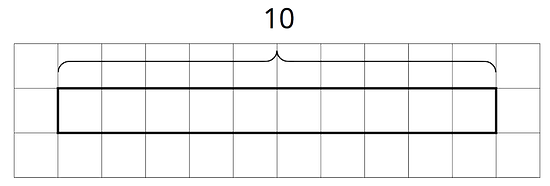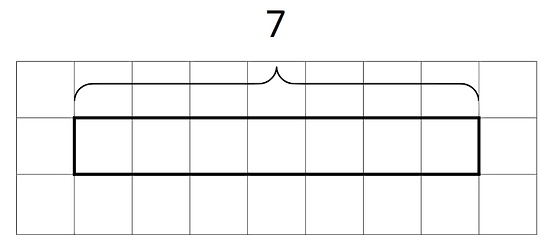Lesson 6Using Diagrams to Find the Number of Groups
Let’s draw tape diagrams to think about division with fractions.
Learning Targets:
- I can use a tape diagram to represent equal-sized groups and find the number of groups.
6.1 How Many of These in That?
- We can think of the division expression as the answer to the question: “How many groups of are in 10?” Complete the tape diagram to represent the question. Then answer the question.

- Complete the tape diagram to represent the question: “How many groups of 2 are in 7?” Then answer the question.

6.2 Representing Groups of Fractions with Tape Diagrams
To make sense of the question “How many s are in 1?,” Andre wrote equations and drew a tape diagram.
-
In an earlier task, we used pattern blocks to help us solve the equation . Explain how Andre’s tape diagram can also help us solve the equation.
-
Write a multiplication equation and a division equation for each of the following questions. Draw a tape diagram to find the solution. Use the grid to help you draw, if needed.
- How many s are in 1?

- How many s are in 3?

- How many s are in 5?

- How many s are in 1?
6.3 Finding Number of Groups
-
For each question, draw a diagram to show the relationship of the quantities and to help you answer the question. Then, write a multiplication equation or a division equation for the situation described in the question. Be prepared to share your reasoning.
- How many -inch thick books make a stack that is 6 inches tall?
- How many groups of pound are in pounds?
- Write a question that can be represented by the division equation . Then answer the question. Show your reasoning.
Lesson 6 Summary
A baker used 2 kilograms of flour to make several batches of a pastry recipe. The recipe called for kilogram of flour per batch. How many batches did she make?
We can think of the question as: “How many groups of kilogram make 2 kilograms?” and represent that question with the equations:
To help us make sense of the question, we can draw a tape diagram. This diagram shows 2 whole kilograms, with each kilogram partitioned into fifths.
We can see there are 5 groups of in 2. Multiplying 5 and allows us to check this answer: and , so the answer is correct.
Notice the number of groups that result from is a whole number. Sometimes the number of groups we find from dividing may not be a whole number. Here is an example:
Suppose one serving of rice is cup. How many servings are there in cups?
Looking at the diagram, we can see there are 4 full groups of , plus 2 fourths. If 3 fourths make a whole group, then 2 fourths make of a group. So the number of servings (the “?” in each equation) is . We can check this by multiplying and .
, and , which is indeed equivalent to .
Lesson 6 Practice Problems
We can think of as the answer to the question “How many groups of are in 3?” Draw a tape diagram to represent the question. Then answer the question.
Describe how to draw a tape diagram to represent and answer for a friend who was absent.
How many groups of days are in 1 week?
- Write a multiplication equation or a division equation to represent the question.
- Draw a tape diagram to show the relationship between the quantities and to answer the question. Use graph paper, if needed.
- Diego said that the answer to the question “How many groups of are in 1?” is or . Do you agree with his statement? Explain or show your reasoning.
Select all equations that can represent the question: “How many groups of are in 1?”
Calculate each percentage mentally.
- What is 10% of 70?
- What is 10% of 110?
- What is 25% of 160?
- What is 25% of 48?
- What is 50% of 90?
- What is 50% of 350?
- What is 75% of 300?
- What is 75% of 48?